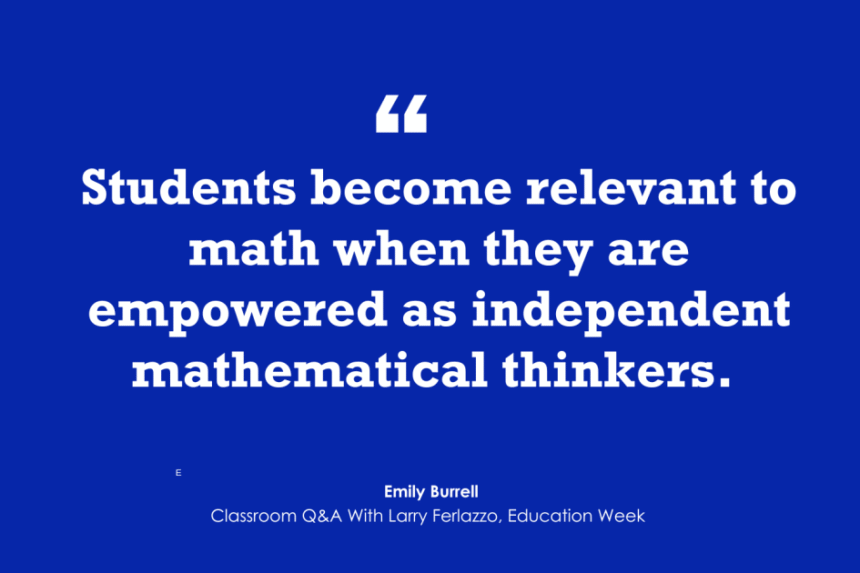Today’s post continues a series highlighting ways teachers can help students see how math and science are relevant to their lives.
Listen!
Emily Burrell has taught high school mathematics for 23 years. For the last 10 years, she taught at Fairfax County’s South Lakes High School in Reston, Va.:
Although students may be doubtful, math is relevant to their lives. Teachers can help students understand this by posing questions in real-world contexts or by engaging in project-based learning. Math is also relevant as a general practice that builds problem-solving ability.
But more importantly, students must learn that they are relevant to mathematics. Students’ ideas about math are important in building their own agency and for supporting their peers’ understanding.????? Many students believe that their math teacher is the holder of all knowledge and the student’s job is to memorize and repeat. They often don’t know the value of their own thoughts until a teacher asks for them.
One of my favorite questions to ask is, “Was math invented or discovered?” This question has both depth and accessibility and has led to enthusiastic debates. Routine questions to ask include, “What patterns do you see?” and “What would be a reasonable estimate of this answer?” and “How is this problem related to one you know how to solve?” In general, ask questions that are open-ended and pose problems that can be solved with multiple methods.
Students know their thoughts are valuable when people listen. Teachers are often in a hurry to help as many students as possible in the limited time we have with them. But stopping to listen carefully to a student’s question, asking about what approaches they tried and what ideas they have next can build a student’s confidence in their ability to tackle problems without teacher help. Patient listening will pay off with students who understand the importance of their ideas.
Students also need to share ideas with their peers. This might not happen naturally if they don’t feel confident in their understanding or don’t know their classmates well. Teachers can create structures for students to share their ideas with routines like “sage and scribe.” They can assign expertise with structures like “jigsaw” so every student has something important to contribute.
When you think about what is important to you, often you have found a way to make your own impact in this area. Math is no different. Thoughtful questioning and structures for discourse allow students to make meaningful contributions to the class and to their peers’ understanding. Students become relevant to math when they are empowered as independent mathematical thinkers.
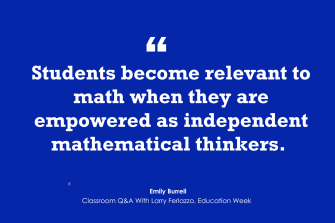
‘Giving Students a Purpose’
Deborah Peart Crayton is the founder and CEO of My Mathematical Mind and speaks on a variety of topics related to math identity, elementary math content and instruction, and literacy connections to mathematics. She is the author of Born a Mather: Leveraging Literacy for Mathematical Understanding:
Elementary students are excited to solve problems and become the hero in someone else’s story. As teachers, we can offer this gift by giving students a purpose for “doing the math.” One way to do this is to show students how math can help them advocate for themselves and others.
When teaching 3rd grade students in Atlanta, our grade was assigned the last lunch block. Just before us, the 4th and 5th grade students had lunch. Each Thursday, there was a limited supply of chocolate milks, which by our lunchtime meant very few to go around. Week after week, my students complained about not getting chocolate milk, so I challenged them to find a solution. They immediately turned to mathematics under my guidance and with a few “wonderings” to probe their thinking.
I wonder how many chocolate milks are ordered each week.
I wonder if all of the students like chocolate milk.
I wonder how many chocolate milks students are allowed to drink.
I wonder how we could find out how much chocolate milk would be enough.
I wonder who could help us solve this dilemma.
Even though it was not a formal assignment, my students were fully invested. They interviewed the lunchroom manager who was responsible for ordering milk. They created a survey for students to find out how many actually like chocolate milk.
They worked together to determine how many chocolate milk cartons should be ordered, with a few extra for good measure, and took their case to the principal. They had graphs, charts, and accurate calculations to demonstrate the problem and their proposed solution. Their diligence was rewarded with a solution that involved ordering more chocolate milk and limiting the number of cartons each student could have. These 3rd graders recognized math as a sense-making superpower.
When designing or modifying tasks, we must ensure the contexts are relevant to the students. Even when following a curriculum, we must feel empowered to adapt the contexts to match our students’ lives. When scenarios are a mismatch for the students, we have a responsibility to keep the math intact while adjusting the context to make it more relatable and meaningful.
When I taught in New York City, we had a survey and graphing task about how the students get to school. The choices were: ride in a car, take the school bus, or walk. I knew my students also traveled by city bus, taxi, or train, so this survey didn’t match our context. It was an easy fix.
Students can help us figure out what is relevant to them, but we need to ask. Student-generated tasks can be included for practice, homework, or group work allowing students to see themselves as creators of mathematics and not doers only.
Another way to include student voice is to launch math with warm-up routines and community builders that invite student discourse. As we get to know our students, it becomes easier to ensure that students see themselves represented in the contexts of our math tasks and as assets to our math communities. We want all students to know they are “mathers.”
As teachers, we often get the question, “When will I ever use this?” If we help students view mathematics as something that can help them make sense of the world, they are more willing to hone their skills.
It is important for them to recognize that practice doesn’t always look like application. You may never need this exact task in life, but you are learning valuable skills in the process of finding solutions. We can turn to the Standards for Mathematical Practice for support with the language we can use with students to help them embrace the habits they learn from working hard in math class.
Below is a student-friendly version of the standards designed for students to have language to describe the skills, habits of mind, and practices they are learning that will serve them not only in math class but in life. Students need to know that as they become deep mathematical thinkers, they are also becoming problem-solvers who can solve all types of problems for themselves and others.
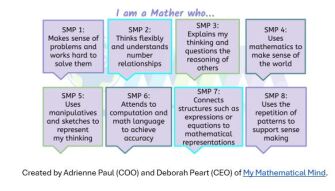
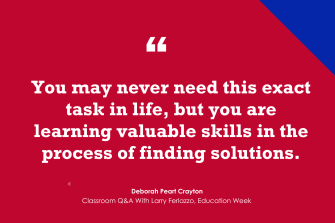
‘Think Long Term’
Ralph Pantozzi is a Presidential Awardee in Mathematics Teaching and has been a classroom teacher and supervisor in New Jersey schools for 32 years:
First, always be honest about why you are teaching a particular topic. Often, the reason is simply to prepare for a future topic. Students will appreciate your candor.
Many educators teach topics that have limited (immediate) relevance, so think long term. Highlight short stories of real people who use the ideas of math and science in their lives and careers. Find out about your students’ interest, concerns, and hobbies. Allocate space on your classroom walls for images of people and objects from the local community and the larger world that have connections to math and science.
Resources like Profiles of Professional Mathematicians and Computational Scientists and Mathematical Moments are also good places to start, but think also about everyday objects like toasters or the newest game show where contestants are trying to strategize their way to victory. A classroom that is connected to the larger world is one where students will always see relevance.
Just as essential: Leave time in your classroom for students to ask questions about topics of interest. Every once in a while, have the “do now” be “ask me a question you’ve been pondering,” letting the students know that their questions need not be restricted to ideas they might think of as having a mathematical connection.
When you read these questions, you learn things about your students and have material for your own investigation. You may not know an immediate through line to math and science, but you will often be able to find one—or you can ask The Math Doctors!
In students’ day-to-day work, another way to show that math and science has meaning is to continually note that mathematical and scientific words are used in other areas of our lives: power, function, degree, origin, term, hypothesis, translate, expand, factor … the list is nearly endless.
When humans chose these words for specialized use, they were thinking of the world beyond math or attempting to make an analogy or metaphor. Math often seems separate from other human endeavors, but at its basis, it is our attempt to understand our world and our experience in it. Let the Online Etymology Dictionary be your guide.
Lastly, relevance is often found simply in what inspires curiosity. A garbage can and a lampshade can be the same shape. The occurrence of floods is much like rolling dice. You only need a mirror half your height to see the full length of your body. the age of geologic structures, and the sound of a bouncing ball all have something in common. Be on the lookout for everyday phenomena that can be used to raise questions about the world we inhabit. A classroom full of interesting questions is one where students often find relevance all on their own.
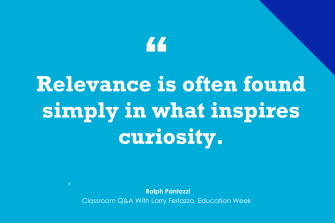
‘Cooperative Learning’
Sarah Nichols is a national board-certified teacher and a Utah Teacher Fellow in Salt Lake City:
One of my favorite teaching assignments as a special education teacher is co-teaching in a secondary math classroom. As much as I love math, it’s pretty hard to convince teenagers that they are going to spend a lot of their adult life graphing lines using slope intercept form or that imaginary numbers are going to be critical to their future happiness.
Secondary students can sniff out halfhearted rationalizations and lame attempts at making connections. It may be fun for me to graph a system of equations to determine when spending $40 on a reusable popcorn bucket at the movie theater would pay off, but despite the widespread appeal of popcorn and personal budgets, it doesn’t seem to be as fun for the students. To an extent, I’m jealous of elementary teachers whose lessons translate into more common real-life applications.
The best way I have seen to make math relevant to students’ lives is to emphasize the real, math-adjacent skills that they can practice and acquire through hard work in math class.
First, and most important, is the ability to persevere through a challenging problem. Instead of giving up at the first sign of frustration, they can hone their skills of struggling through, trying a new tack, and checking to see if an answer is correct. This is especially important in the post-COVID era. Too many students were able to avoid the discomfort of struggling through problems and disengaged significantly during online schooling. It’s easy to make a case for the relevance of being able to stick with a problem until a solution is found or accessing past knowledge and previously used strategies to apply to a new problem.
In addition, students in math classes that utilize cooperative learning or discourse-promoting strategies have the benefit of practicing communication and cooperation, two skills that are crucial in almost every work context and in current or future relationships. Math teachers can help students learn more than just math—they can teach and support the social skills needed to be successful in life, such as explaining thoughts clearly, listening to others, adding on to others’ ideas, and challenging thinking errors.
When teachers link math standards to esoteric or less-than-relatable future applications, they lose the opportunity to show students what they are really learning— concrete, relevant skills that successful adults need in their relationships, workplaces, and homes.
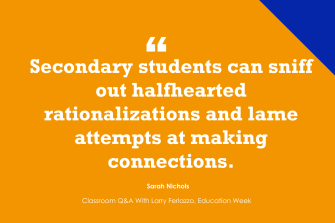
Thanks to Emily, Deborah, Ralph, and Sarah for contributing their thoughts!
Today’s post answered this question:
What are the best strategies teachers have used to help students see what they are learning in math and/or science is relevant to their lives?
In Part One, K. Renae Pullen , Neven Holland, and Cindy Garcia shared their recommendations.
Consider contributing a question to be answered in a future post. You can send one to me at lferlazzo@epe.org. When you send it in, let me know if I can use your real name if it’s selected or if you’d prefer remaining anonymous and have a pseudonym in mind.
You can also contact me on Twitter at @Larryferlazzo or on Bluesky at @larryferlazzo.bsky.social .
Just a reminder; you can subscribe and receive updates from this blog via email. And if you missed any of the highlights from the first 13 years of this blog, you can see a categorized list here.
